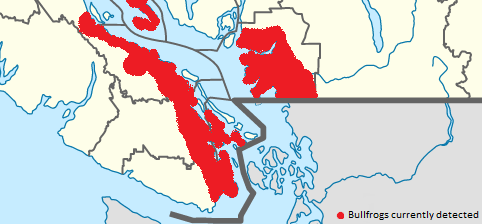As a biodiversity enthusiast, I am always hopeful that new species (particularly vertebrates!) will move into the Science Park. Having recently heard that a frog had decided to call the pond home, I was naturally thrilled. Until, that is, I found out that it was none other than an American Bullfrog, a species that poses a major threat to BC’s native pond life.
The American Bullfrog is actually native to some parts of Canada, although not to the westcoast. Its natural range lies in the eastern part of North America, from Canada as far south as Florida. It was introduced to BC in the early 20th century by individuals on Vancouver Island who thought that there might be room in the market for farmed frog’s legs.
Adult bullfrogs can reach up to 20cm in length and can weigh up to 800g. They have smooth, unwarty skin (unlike toads: this is a nice distinguishing feature between frogs and toads in general!), and have large, circular eardrums, or tympanum, behind the eye. During mating season, you will hear male bullfrogs make a distinctive, low pitch call, unlike anything you might imagine a frog making. The call resembles a cow moo, which is actually where the name “bullfrog” arises from.
The frog-leg-farm venture did not take off as planned, which led to their release into the wild. And as we have seen many times in history, introducing non-native species, like this frog, to a new area usually comes with unpredicted and unwanted consequences (just ask Australia!)

You might ask: “What's the problem with a frog that lives in one part of Canada moving into another part of Canada?” The problem is, there are no bullfrog predators in BC to keep it in check.
The American bullfrog is the largest frog in North America, and is a voracious predator of pretty much anything you can imagine living in a wetland habitat: small invertebrates, birds, small mammals, snakes and other frogs. It will basically eat anything that it can fit into it’s large mouth. Without predators to keep it in check, the bullfrog population has the ability to explode out of control, with seriously negative effects on local wildlife.
It doesn’t help that a female bullfrog can lay an egg mass containing up to 20,000 eggs and therefore has the ability to make lots of new mini predators in a short space of time! On top of all this, the Bullfrog is an aposematic carrier of the fungal infection chytridiomycosis Batrachochytrium dendrobatidis, meaning it can carry and transmit the deadly disease, which has been implemented in amphibian decline and extinction worldwide, to other amphibians, without experiencing symptoms itself.
The Bullfrog population is now established across the Lower Mainland and southern Vancouver Island, and has also been found in the South Okanagan. Some efforts are being made to physically remove frogs one by one, however some scientists think that we are past the point of being able to eradicate bullfrogs from BC.
You can help stop the bullfrog invasion by not buying bullfrogs for ornamental ponds, by never moving a bullfrog from one pond to another, and also by not buying tadpoles to use as fish bait. It will take the teamwork of British Columbians everywhere to ensure that our wonderful native fauna survives the siege of the bullfrog for years to come!
When you next visit Science World, keep an eye (and your ears) out for our uninvited guest in our Science Park pond.